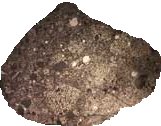
March Editorial
Carancas meteorite

March Editorial
Carancas meteorite
|
|
On the 15th of September 2007 numerous people near Carancas in the remote Puno region in Peru reported seeing a large fireball plunge from the sky. According to eyewitnesses the object smashed into the ground leaving a crater 30m wide and 6m deep. Those who came to investigate this crater afterwards said they had been made ill from noxious gasses which it was spewing. No one knew really knew what had happened, and some experts were rather skeptical that anything had fallen from the sky at all. As Dr Caroline Smith, a meteorite expert at the London-based Natural History Museum has remarked: "Increasingly we think that people witnessed a fireball, (which is not uncommon), and went off to investigate and found a lake of sedimentary deposit, which may be full of smelly [explosive], methane-rich organic matter". But a team of scientists went to the crater to collect samples and quickly confirmed that the people of Peru had indeed witnessed a meteorite coming to earth. What is more, analysis of the meteorite samples from the site challenge conventional theories about meteorites. The Carancas meteorite has turned out to be a stony meteorite, i.e. one composed mostly of silicate minerals (75-90% by weight), together with nickel-iron metal alloy (10-25%), and iron sulphide. Such meterorites account for 95% of all known falls. The majority (86% of all falls) are chondrites - meteorites formed when various types of dust and small grains that were present in the early solar system accreted to form primitive asteroids. Prominent among the components of chondrites are the enigmatic chondrules, millimeter-sized objects that originated as freely floating, molten or partially molten droplets in space. The others are achondrites; as the name indicates, meteorites that lack chondrules. Achondrites are formed by igneous processes on or near the surface of larger asteroids or planets. Many achondrites resemble igneous rocks on Earth, especially basalt. So the fact that Peruvian meteorite was a stony meteorite was no great surprise. What baffles scientists is its size. Stony meteorites are fragile and during their fiery descent through Earth's atmosphere, these are supposed to fragment into smaller pieces and scatter over a wide area. And yet the scientists investigating the Carancas site found evidence that this meteorite was was approximately 1 meter in diameter, and was intact when hit the ground. The details of the findings were presented during the recent Lunar and Planetary Science Conference in Houston, Texas. Two theories were put forward to explain how meteorite came down intact:
Some scientists, however, remain sceptical about both interpretations. There is no doubt that more research will be needed to unravel the mystery. Meanwhile it is possible that there are more small craters out there which have been caused by stony meteorites but have not been recognised as such. Large buried iron meteorites are relatively easy to detect, but pieces of stony meteorite become intimately mixed with terrestrial soil. Once they hit the ground they literally blend into the scenery. |
| _______________________________ | ||||
| Home | | | Shopping | | | Database |
© Biscuit Software 2004-2015
All rights reserved